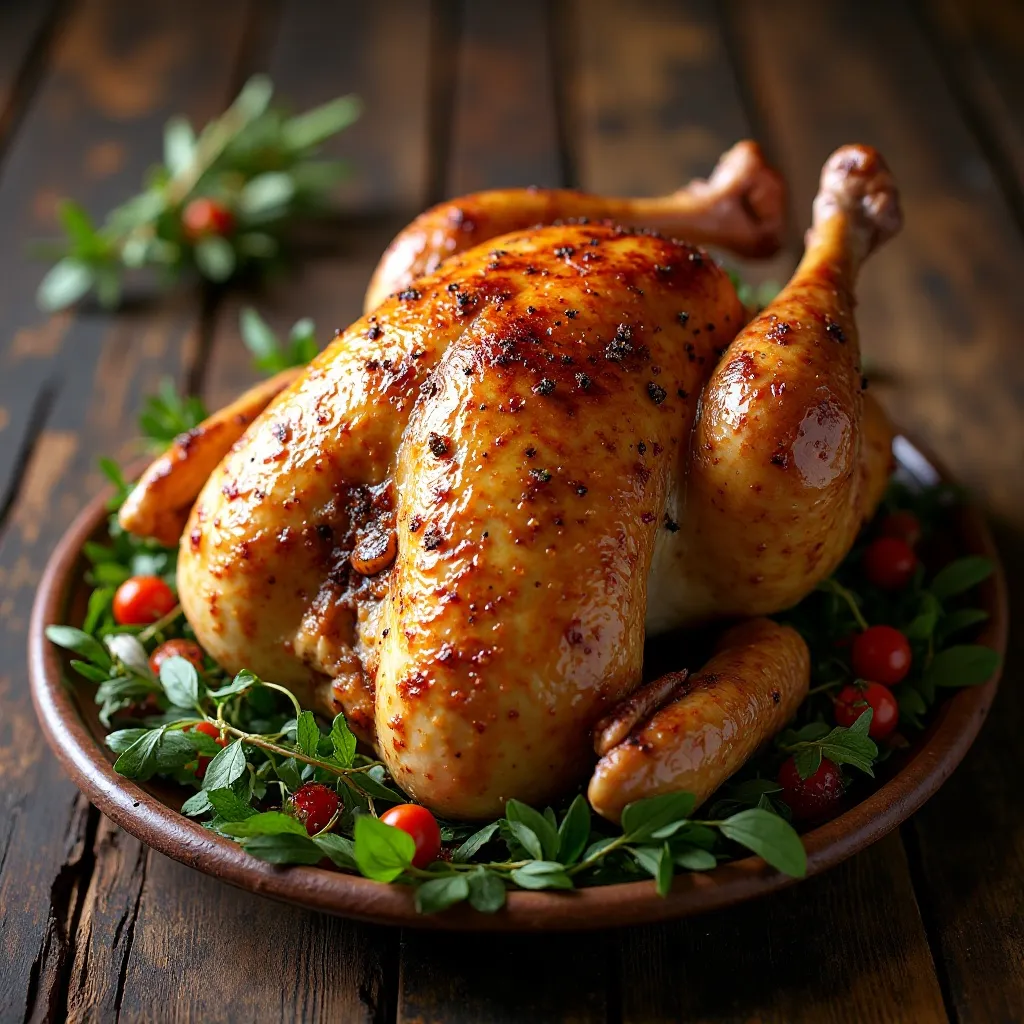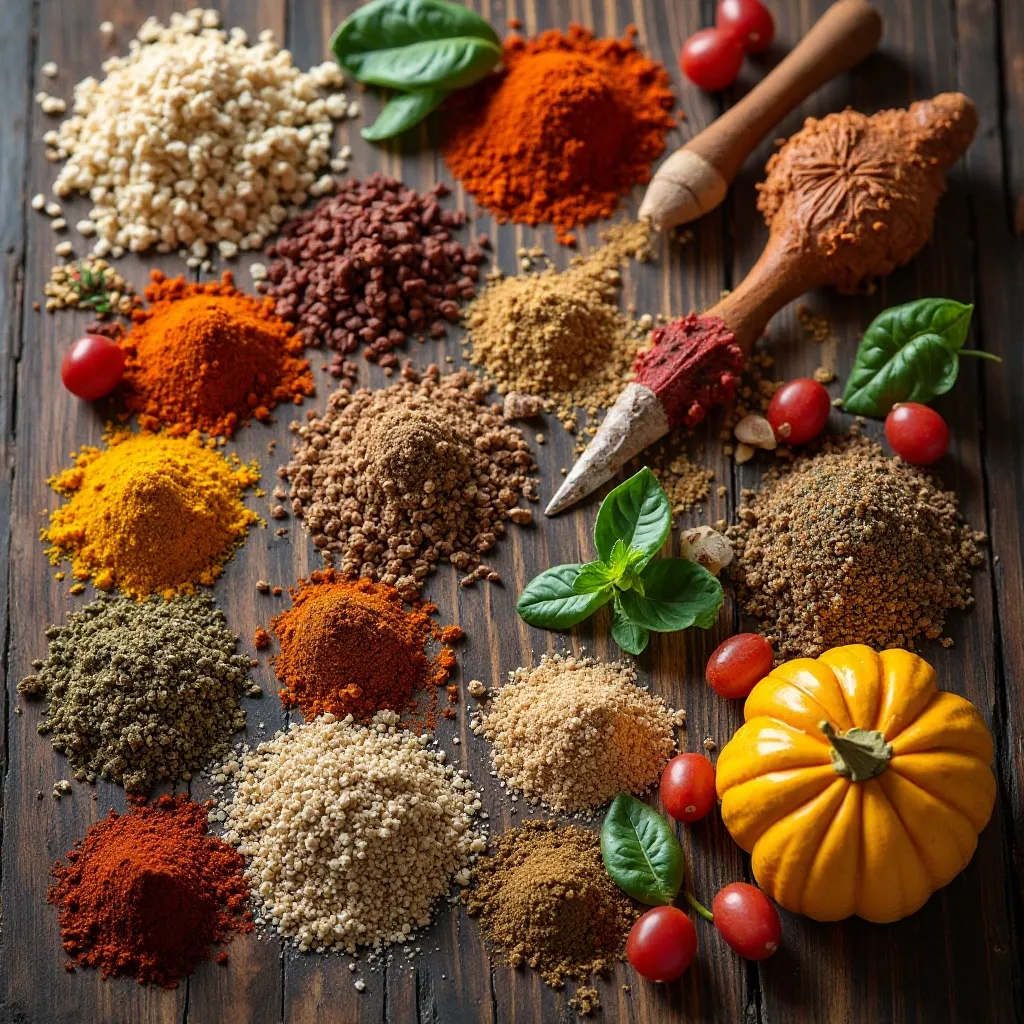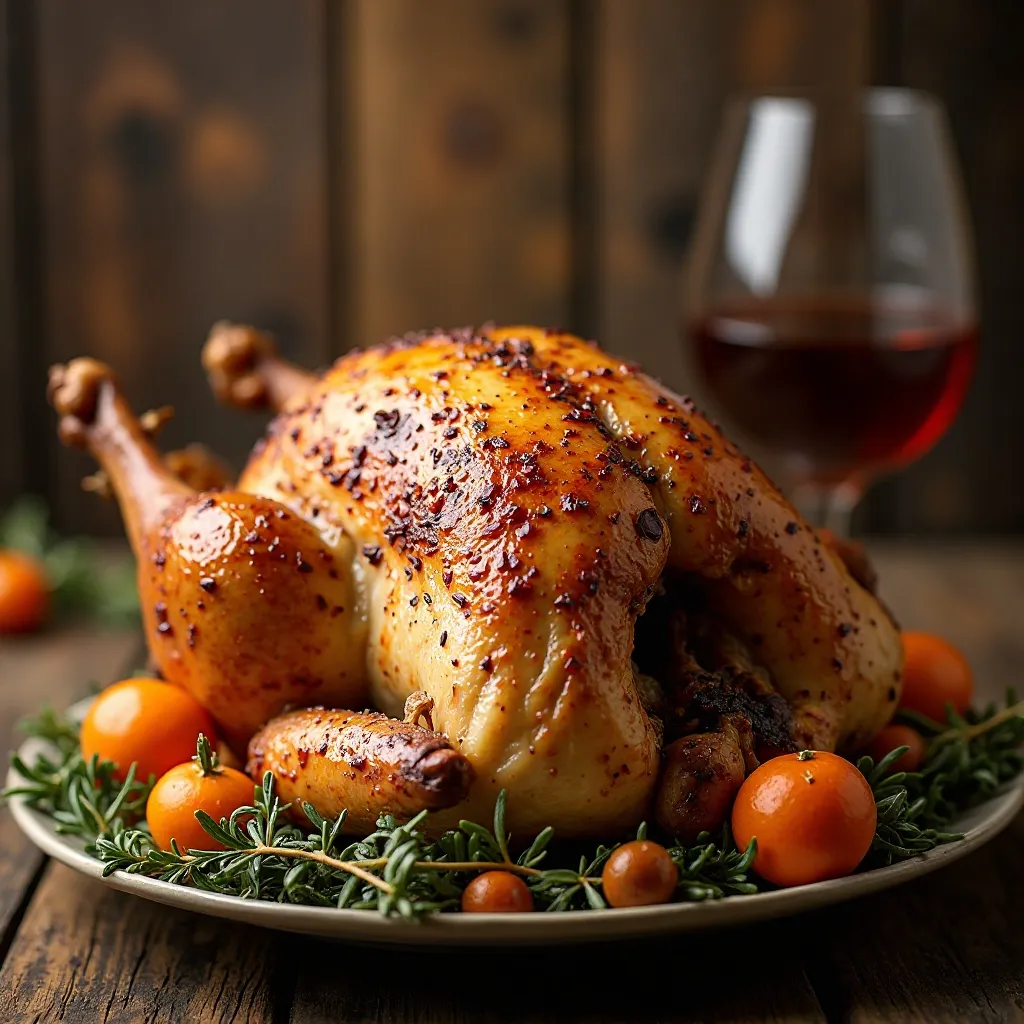Best Thanksgiving Turkey Rub – The Secret to Crispy Turkey
Picture this: golden-brown, crispy skin giving way to tender, juicy meat bursting with aromatic herbs and spices. That’s exactly what you’ll get with this incredible thanksgiving turkey rub! This magical blend of herbs and spices transforms an ordinary turkey into the star of your holiday table.
It’s ridiculously simple to make, takes just 5 minutes to prepare, and uses pantry staples you probably already have. Your family will be asking for seconds (and thirds!).
What is Thanksgiving Turkey Rub?
Ever wondered why some turkeys taste like pure magic while others are just… meh? The secret weapon is a thanksgiving turkey rub! This aromatic blend of herbs, spices, salt, and sometimes sugar creates a flavorful crust that seals in moisture and adds incredible depth to your bird.
Think of it as a spa treatment for your turkey – but instead of cucumbers and face masks, we’re using rosemary, thyme, and paprika! After all, they say the way to a man’s heart is through his stomach, and nothing says “I love you” quite like a perfectly seasoned holiday turkey. Ready to become the turkey hero of your family? Let’s dive in!

Why You’ll Love This Thanksgiving Turkey Rub
It’s Incredibly Flavorful
This thanksgiving turkey rub is packed with aromatic herbs like rosemary, thyme, and sage that scream “holiday feast!” The warm spices including paprika and black pepper add depth, while garlic powder brings savory goodness. Every bite delivers a perfect balance of herbaceous, savory, and slightly sweet notes that complement the natural richness of turkey meat.
Save Money and Skip the Store-Bought Versions
Why spend $8-12 on pre-made turkey rubs when you can create a superior version at home for a fraction of the cost? Store-bought rubs often contain fillers, excess sodium, and mystery ingredients you can’t pronounce. Making your own thanksgiving turkey rub means you control exactly what goes on your bird. Plus, you’ll have enough to use on multiple dishes throughout the season!
Versatile Beyond Turkey
While this rub is designed for your Thanksgiving centerpiece, it’s incredibly versatile. Use it on chicken breasts for weeknight dinners, sprinkle it on roasted vegetables, or even incorporate it into your favorite stuffing recipe. Speaking of versatility, if you love herb-forward flavors, you’ll also want to check out our Garlic Herb Roasted Chicken recipe for another crowd-pleasing option.
The best part? You can make a big batch and store it in an airtight container for months. Come Thanksgiving morning, you’ll be stress-free and ready to go. No last-minute grocery store runs or panic about seasoning. Just pull out your homemade rub, massage it onto your turkey, and let the oven work its magic!
How to Make Thanksgiving Turkey Rub
Quick Overview
This thanksgiving turkey rub comes together in just 5 minutes with simple mixing. No cooking required!
The aromatic blend creates a flavorful, crispy exterior on your turkey while locking in natural juices.
You’ll love how the herbs and spices meld together to create complex, restaurant-quality flavor.
Prep Time: 5 minutes Total Time: 5 minutes (plus turkey seasoning time) Yield: Enough rub for one 12-15 lb turkey
Key Ingredients for Thanksgiving Turkey Rub
- 3 tablespoons brown sugar (adds caramelization and balances savory flavors)
- 2 tablespoons kosher salt (essential for seasoning and moisture retention)
- 1 tablespoon black pepper, freshly ground (provides subtle heat)
- 1 tablespoon smoked paprika (creates beautiful color and smoky depth)
- 2 teaspoons dried rosemary, crushed (classic holiday herb)
- 2 teaspoons dried thyme (earthy and aromatic)
- 2 teaspoons dried sage (quintessential Thanksgiving flavor)
- 1 teaspoon garlic powder (savory backbone)
- 1 teaspoon onion powder (adds sweetness and depth)
- ½ teaspoon cayenne pepper (optional, for a subtle kick)
- Zest of 1 lemon (brightens all the flavors)

Step-by-Step Instructions
Gather Your Ingredients
Start by assembling all your dried herbs and spices on your counter. Make sure your herbs are relatively fresh – if they’ve been sitting in your pantry for years, it’s time to replace them. The difference in flavor is night and day. Crush the dried rosemary between your fingers to release its oils and break it into smaller pieces.
Combine the Dry Ingredients
In a medium mixing bowl, add the brown sugar, kosher salt, black pepper, smoked paprika, crushed rosemary, dried thyme, dried sage, garlic powder, and onion powder. If you’re using cayenne pepper for a little heat, add it now. Use a whisk or fork to thoroughly blend all ingredients together, breaking up any clumps in the brown sugar.
Add Fresh Elements
Zest your lemon directly into the spice mixture. The citrus oils will begin to release immediately, creating an incredibly fragrant blend. Mix everything together until the lemon zest is evenly distributed throughout the rub. The mixture should smell absolutely amazing at this point!
Store or Use Immediately
If you’re making this ahead of time, transfer the thanksgiving turkey rub to an airtight container or jar. Store it in a cool, dry place for up to 3 months. When you’re ready to use it, give the container a good shake to redistribute the ingredients. If you’re using it right away, proceed to season your turkey!
Apply to Your Turkey
For a 12-15 lb turkey, this recipe provides the perfect amount of rub. Pat your turkey completely dry with paper towels – this is crucial for crispy skin. Gently loosen the skin from the breast meat by carefully sliding your fingers between the skin and meat. Rub about one-third of the mixture directly onto the meat under the skin. Massage the remaining rub all over the outside of the turkey, getting into all the nooks and crannies. Don’t forget the legs and wings!
Let It Rest
For maximum flavor, let the seasoned turkey rest uncovered in the refrigerator for at least 2 hours, or ideally overnight. This allows the salt to penetrate the meat and the flavors to develop. The surface will also dry out slightly, which promotes even better skin crispiness during roasting.
What to Serve Thanksgiving Turkey Rub With
Your perfectly seasoned turkey deserves equally delicious sides! Pair it with creamy mashed potatoes that soak up all those flavorful pan drippings. Classic green bean casserole adds a comforting, crispy-topped vegetable option. Don’t forget homemade cranberry sauce for a tart contrast to the savory rub.
Sweet potato casserole with marshmallow or pecan topping provides a sweet element that complements the herbs beautifully. Fresh dinner rolls are essential for making turkey sandwiches with leftovers. For beverages, serve a medium-bodied red wine like Pinot Noir or a crisp white wine such as Chardonnay.
Consider adding roasted Brussels sprouts with bacon for a trendy, flavorful side. A traditional cornbread stuffing picks up the sage notes in your rub beautifully. Round out the meal with a simple mixed green salad dressed with vinaigrette to cut through the richness.
Top Tips for Perfecting Thanksgiving Turkey Rub
Choose Quality Ingredients
The flavor of your rub depends entirely on the quality of your spices. Purchase dried herbs and spices from stores with high turnover, or better yet, visit a specialty spice shop. Check expiration dates and smell your spices before using them. They should be fragrant and vibrant. Dull-smelling spices will produce dull-tasting turkey.
Adjust Heat Levels to Preference
The cayenne pepper is completely optional. If you’re cooking for people who don’t enjoy any spice, omit it entirely. For those who love heat, you can increase it to a full teaspoon. You can also substitute cayenne with red pepper flakes for a different type of heat profile.
Consider Turkey Size
This recipe is perfectly proportioned for a 12-15 lb turkey. If you’re cooking a larger bird (18-20 lbs), make 1.5 times the recipe. For a smaller turkey (8-10 lbs), make just two-thirds of the recipe. You want full coverage without overwhelming the natural turkey flavor.
Don’t Skip the Overnight Rest
While you can apply the rub and cook immediately, letting it rest overnight makes a huge difference. The salt acts as a dry brine, penetrating deep into the meat for better seasoning throughout. This also helps the skin dry out, resulting in crispier, more golden-brown skin.

Customize Your Blend
Feel free to adjust the ratios to suit your taste preferences. Love rosemary? Add an extra teaspoon. Want more smokiness? Increase the paprika. Some people prefer white pepper instead of black for a milder flavor. Make this thanksgiving turkey rub your own!
Apply Under and Over Skin
The biggest mistake people make is only seasoning the outside of the turkey. By applying rub under the skin directly on the breast meat, you ensure the actual meat is flavorfully seasoned, not just the skin. Be gentle when loosening the skin to avoid tearing it.
Use Fresh Lemon Zest
The lemon zest is the secret ingredient that makes this rub special. It brightens all the other flavors and adds a subtle freshness that cuts through the richness. Always use fresh zest, never bottled lemon juice or dried zest. The oils in fresh zest are irreplaceable.
Storing and Reheating Tips
Storing the Rub
Your unused thanksgiving turkey rub stays fresh for up to 3 months when stored properly. Transfer it to an airtight glass jar or container with a tight-fitting lid. Keep it in a cool, dark place like your spice cabinet. Avoid storing near the stove where heat and humidity can cause clumping and reduce potency.
Write the date on the container so you know when you made it. If the lemon zest hasn’t been added yet, the rub will last even longer – up to 6 months. Only add fresh lemon zest when you’re ready to use it.
Storing Cooked Turkey
After your Thanksgiving feast, remove all meat from the turkey bones within 2 hours of cooking. Store the meat in airtight containers or resealable bags, separating white and dark meat if desired. Refrigerate cooked turkey for up to 4 days. For longer storage, freeze turkey meat for up to 3 months in freezer-safe bags or containers.
Pour any remaining pan drippings into a separate container and refrigerate. Once chilled, you can easily remove the fat layer from the top. Save these drippings for making gravy or adding to leftover dishes.
Reheating Turkey
To reheat turkey while maintaining moisture, place sliced turkey in a baking dish with a few tablespoons of chicken broth or pan drippings. Cover tightly with foil and heat in a 325°F oven for 20-25 minutes until warmed through. The liquid creates steam that prevents drying.
For quick reheating, microwave individual portions with a damp paper towel covering the meat. Heat in 30-second intervals to avoid overcooking. Alternatively, make turkey soup, casseroles, or pot pie with leftovers where reheating concerns are minimal.
Common Mistakes to Avoid
Using Wet Turkey
The number one mistake is not properly drying your turkey before applying the rub. Excess moisture prevents the rub from adhering properly and interferes with skin crisping. Always pat the entire turkey completely dry with paper towels, inside and out, before seasoning.
Applying Too Much or Too Little Rub
Finding the right balance is key. Too little rub means bland turkey, while too much can make it overly salty or overpower the natural meat flavor. Use the entire recipe for a 12-15 lb bird, distributing it evenly. The turkey should have visible coverage but not be caked in seasoning.
Not Letting Herbs Release
Dried herbs contain oils that need to be released for maximum flavor. Always crush dried rosemary between your fingers before adding it to the mix. If your herbs are whole or in large pieces, consider pulsing them briefly in a spice grinder for better distribution and flavor release.
Forgetting to Season Inside the Cavity
Many cooks focus solely on the exterior and forget the cavity. Sprinkle some of your rub inside the turkey cavity along with aromatics like onions, celery, and additional fresh herbs. This seasons the bird from the inside out and creates amazing aromas while roasting.
Mixing Fresh and Dried Herbs Incorrectly
This recipe uses dried herbs specifically because they’re concentrated and won’t burn during long roasting times. If you want to use fresh herbs instead, you’ll need to triple the amount (1 tablespoon dried = 3 tablespoons fresh). However, fresh herbs are better stuffed inside the cavity rather than used in the rub itself.
Skipping the Lemon Zest
Don’t skip this ingredient! The lemon zest provides brightness and helps balance the rich, savory flavors. It’s not about making the turkey taste lemony – it’s about enhancing all the other flavors. Just be sure to zest only the yellow part of the peel, avoiding the bitter white pith underneath.
Frequently Asked Questions
Can I use this thanksgiving turkey rub on a frozen turkey?
No, always thaw your turkey completely before applying any rub. A frozen or partially frozen turkey won’t absorb the flavors, and the rub won’t adhere properly to icy skin. Plan ahead and allow 24 hours of refrigerator thawing time for every 4-5 pounds of turkey.
How far in advance can I season my turkey with the rub?
You can apply the thanksgiving turkey rub up to 24 hours before roasting. The sweet spot is between 12-24 hours, which allows the salt to penetrate the meat like a dry brine while the herbs infuse their flavors. Any longer than 24 hours and the salt may draw out too much moisture.
Can I use this rub on turkey breast only?
Absolutely! This thanksgiving turkey rub works beautifully on bone-in turkey breasts. Use about half the recipe for a 5-6 lb turkey breast. The cooking time will be shorter – typically 1.5 to 2 hours at 325°F, depending on size.
Is this rub gluten-free?
Yes, this thanksgiving turkey rub is naturally gluten-free when you use pure spices and seasonings. Always check your spice labels to ensure no fillers or anti-caking agents containing gluten have been added. Most pure dried herbs and spices are gluten-free.
Can I make this rub without sugar?
You can omit the brown sugar if desired, though it does serve important purposes. The sugar helps with caramelization and balances the savory elements. If you’re avoiding sugar, you could substitute with a small amount of granulated garlic or increase the onion powder for sweetness.
Will this rub make my turkey skin crispy?
Yes! The combination of letting the rubbed turkey rest uncovered in the refrigerator (which dries the skin) and the rub itself promotes beautiful browning and crispiness. Make sure your oven temperature is at least 325°F and consider increasing it to 425°F for the last 30 minutes of roasting.
Can I use fresh herbs instead of dried?
While dried herbs work best for rubs due to their concentrated flavor and stability during long cooking times, you can use fresh herbs. Triple the amount (1 tablespoon dried = 3 tablespoons fresh chopped). However, fresh herbs may burn during roasting, so it’s better to stuff them inside the cavity or under the skin rather than on top.
What if I don’t have smoked paprika?
Regular sweet paprika works perfectly fine as a substitute. You’ll lose the subtle smoky flavor, but the rub will still be delicious. Alternatively, add a tiny pinch of chipotle powder (¼ teaspoon) along with sweet paprika to mimic that smokiness.
Can I use table salt instead of kosher salt?
Table salt is much finer and saltier by volume than kosher salt. If using table salt, reduce the amount to 1 tablespoon instead of 2 tablespoons. Otherwise, your turkey may be too salty. Kosher salt is preferred because its larger flakes distribute more evenly and are easier to control.
How do I know if my dried herbs are still good?
Smell and appearance are your best indicators. Dried herbs should be fragrant and vibrant in color. If they smell like nothing or look faded and brown, they’re past their prime. Most dried herbs and spices lose potency after 1-2 years. Replace them for best results.
Nutrition Information
| Nutrient | Per Serving (3 oz turkey with rub) |
|---|---|
| Calories | 165 |
| Protein | 26g |
| Fat | 6g |
| Saturated Fat | 2g |
| Carbohydrates | 2g |
| Sugar | 1g |
| Sodium | 380mg |
| Fiber | 0g |
| Cholesterol | 70mg |
Note: Nutrition information is approximate and based on turkey breast meat with rub. Dark meat will have higher fat and calorie content.
Final Thoughts
This thanksgiving turkey rub is truly a game-changer for your holiday meal. The combination of aromatic herbs, warm spices, and that secret ingredient – lemon zest – creates layers of flavor that make every bite memorable.
What makes this recipe special is its simplicity and flexibility. You can make it weeks in advance and have it ready whenever you need it. The ingredients are affordable and likely already in your pantry. And the best part? It works on so much more than just turkey!
The key to success is using quality spices, properly drying your turkey before application, and giving the rub time to work its magic overnight. These simple steps ensure you’ll have the most flavorful, juicy turkey with incredibly crispy, golden-brown skin.
Don’t be intimidated by cooking a whole turkey. With this thanksgiving turkey rub in your arsenal, you’re already halfway to success. Your family and friends will be raving about your turkey for years to come, asking for your “secret recipe.” And now you have it!
So this Thanksgiving, skip the expensive store-bought rubs with mystery ingredients. Take five minutes to whip up this homemade blend, and get ready for the most compliments you’ve ever received on your turkey. Happy cooking, and happy Thanksgiving!
Have you tried this thanksgiving turkey rub recipe? Leave a comment below and let me know how it turned out! Don’t forget to rate the recipe and share photos of your beautiful turkey. I love seeing your creations!
